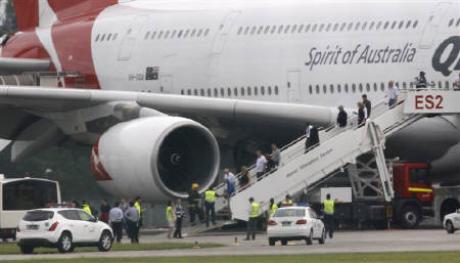AusSMC: Our colleagues at the AuSMC and UK SMC rounded up expert comments on the Qantas Airbus A380 engine failure and second Qantas mid-air engine incident involving a Boeing 747-400 jumbo on Friday.
 Associate Professor Lachlan Thompson leads the Aerospace Design program at RMIT and is an expert on flight vehicle and flight systems design. He is available for expert comment on the safety features of Airbus A380s, Boeing 747s and their Rolls-Royce engines.
Associate Professor Lachlan Thompson leads the Aerospace Design program at RMIT and is an expert on flight vehicle and flight systems design. He is available for expert comment on the safety features of Airbus A380s, Boeing 747s and their Rolls-Royce engines.
“All widebody civil airliners are designed to operate safely with the loss of an engine, so it’s not surprising that the two Qantas aircraft were able to land safely. Engineers design engines in such a way that if they do blow up, damage to other vital parts of the aircraft is minimal. So, though it can look very dramatic, the break-up of an engine is not necessarily catastrophic for the airplane.
“Qantas appears to have followed the directives given by Rolls Royce. So they have done the right thing. The European airworthiness inspection directive issued in August for the Trent engine raised concerns of excessive wear in the engine. Airborne volcanic ash may contribute to this wear but this suggestion is yet to be substantiated.”
Note: see below for the airworthiness directive from the European Aviation Safety Agency.
Summary of the Airworthiness Directive
In January, the European Aviation Safety Agency issued an airworthiness directive (AD) for the Trent 900 engine intermediate pressure (IP) shaft which, if not performed, could result in an uncontained engine failure similar to those that have affected a Trent 1000 Rolls Royce is developing for the Boeing 787. The AD says wear beyond normal limits had been identified on the abutment faces of the splines on the Trent 900 IP shaft rigid coupling on several engines during strip.
As the shaft-to-coupling spline interface provides the means of controlling the turbine axial setting, the wear through of the splines would permit the IP turbine to move rearward, the directive adds. This rearward movement would enable contact with static turbine components and would result in loss of engine performance with potential for in-flight shut down, oil migration and oil fire below the [low-pressure] turbine discs prior to sufficient indication resulting in loss of [low-pressure] turbine disc integrity.
Expert comments from the UK SMC:
Prof Nick Cumpsty, Emeritus Professor of Mechanical Engineering at Imperial College, London:
“Shutting down an engine in flight is uncommon, but it does happen occasionally and does not involve any significant risk to the aircraft or passengers. There is no reason to think there is any connection between the A380 event and the more recent one affecting the B747 except they are both Qantas and both have Rolls-Royce engines. This is a mixture of coincidence and the media being on the alert for events happening to both companies.”
Regarding the possibility of volcanic ash being involved in the first incident:
Dr Ranjan Vepa, Lecturer in Avionics at Queen Mary, University of London:
“It seems quite problematic to pinpoint the cause of the uncontained engine failure that took place on Qantas Flight QF32 after takeoff from Singapore’s Changi Airport en-route to Sydney. The aircraft turned back within 15 minutes. While the failure could have been triggered by one of three reasons, an external enabling event such as a bird strike, by improper maintenance or due to an engine failure, it does not appear to be related to the Indonesian volcano Mount Merapi’s eruptions over the island of Java. Yet one cannot discount the possibility of ash clouds travelling several hundreds of miles and being trapped in the atmosphere over the region south of Singapore and north of the Indonesian Batam island, and possibly triggering the uncontained engine failure. In fact the prevailing winds over Mount Merapi are currently North westerly and this has prompted Indonesian geologists to suggest that the volcanic ash could have reached Jakarta by November 3rd. Given that the southern tip of Batam Island is about the same distance from Mount Merapi as Jakarta, it is not impossible for the volcanic ash to have arrived at the point where the AIRBUS A380 turned back after experiencing the engine failure.
“The uncontained engine failure could also have been caused by a combination of circumstances which could have triggered a sequence of enabling events leading to the uncontained engine failure almost immediately after take-off. This naturally tends to make one suspect that the engine was probably hit by something that caused the engine inlet to be blocked which in turn could have triggered a sequence of events leading to the turbine trying to operate faster or even a “fire” within the combustion chamber.
“It is not entirely clear if the failure is related to the applicable Airworthiness Directive (AD) issued by European Aviation Safety Agency (EASA) (AD No.: 2010-0008R1 on Date: 04 August 2010). I feel it is best to await the verdict of the official investigators rather than try and quickly apportion the blame unfairly on AIRBUS, Rolls Royce or Qantas for snappy commercial reasons.”